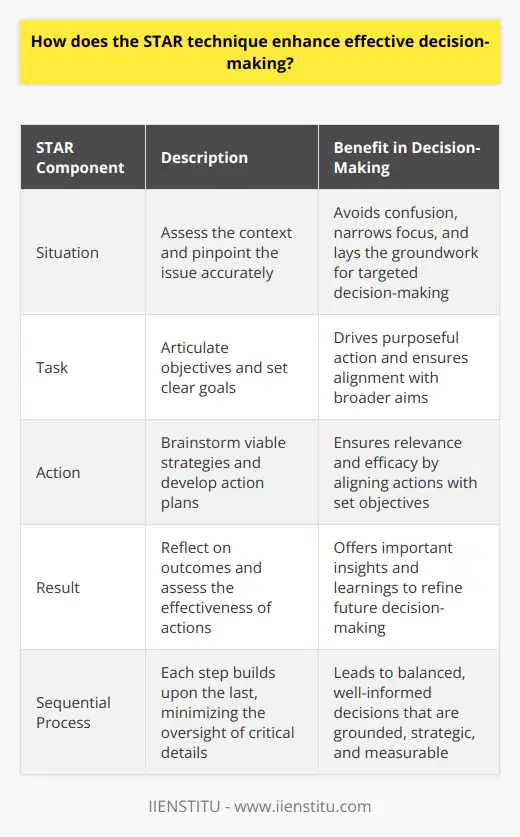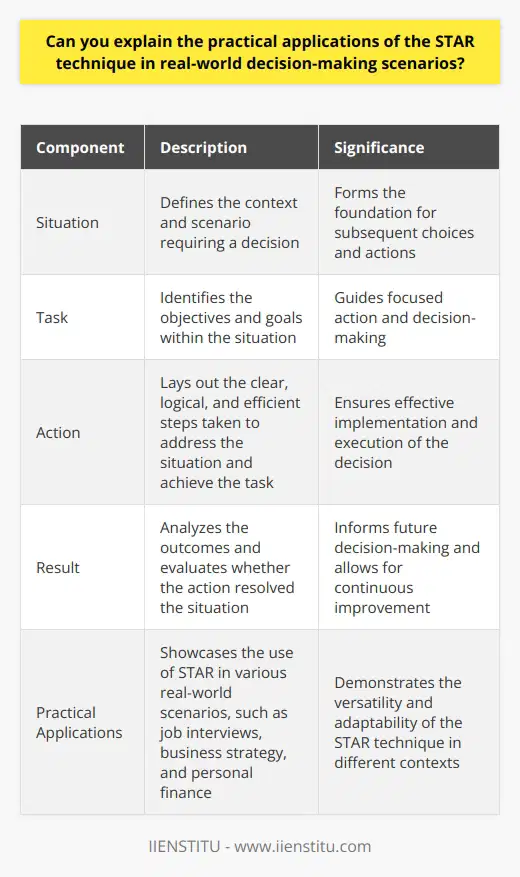
The value of precise and informed decision-making cannot be overstated in today's complex and fast-paced world. The ability to analyze a situation, understand the challenges, formulate an action plan, and reflect on the results is critical across numerous contexts, from personal life management to strategic corporate activities.
Within this framework, the STAR Technique emerges as a revolutionary decision-making strategy that empowers individuals and organizations to navigate the murky waters of uncertainty with confidence.
As an author with a comprehensive focus on this method, this article aims to unpack the layers of the STAR acronym—Situation, Task, Action, Result—providing readers with a blueprint of effective decision-making. We will explore a myriad of scenarios that showcase the utility of the STAR Technique, ensuring that the outcome of this discourse leaves a lasting imprint on one's problem-solving toolkit.
Understanding the STAR Technique
Definition and breakdown of the STAR acronym
The STAR Technique is a structured method that guides an individual through a process that starts with a detailed description of a Situation—contextualizing the environment or problem at hand. Then, we identify the Task that needs to be addressed—setting clear objectives and outlining the scope of the challenges present.
The Action phase involves strategizing and implementing steps that tackle the identified task. Finally, examining the Result instructs on evaluating the effectiveness of the action taken and the consequences that ensued. By splitting decision-making into these four distinct stages, the STAR Method allows for a more analytical and less impulsive approach to solving problems.
Historical background and evolution of the STAR Technique
Originally conceived within the arena of behavioral interviews, the STAR Technique has expanded far beyond its initial use as a communication tool for job candidates to describe their past experiences effectively.
This framework evolved into a universal problem-solving and decision-making strategy as professionals realized its potential in breaking down complex situations into manageable components. Over time, the pragmatic value of this technique has been recognized in diverse areas such as business management, education, and even conflict resolution.
Importance of the STAR Technique in personal and professional settings
The versatility of the STAR Technique makes it a valuable asset in both personal decision-making and organizational problem-solving. For individuals, using this method can lead to more considered decisions in daily life, from career moves to financial planning.
Professionally, it can enhance project management, improve team dynamics by offering a common language for problem-solving, and assist in risk assessment by breaking down issues into more easily assessed components. In complex settings, where variables are numerous and implications profound, the STAR Method provides a robust approach for tackling challenges methodically.
How the STAR Technique Enhances Decision-Making
The role of structured thinking in improving clarity
Deliberate and structured thinking is at the core of the STAR Technique's effectiveness. By obliging decision-makers to approach problems systematically, the technique ensures that each element of a situation receives ample consideration.
Clarity emerges as issues are dissected into the specific tasks they encompass, actions to be taken are deliberated, and possible and actual outcomes are scrutinized. This methodical approach minimizes overlooked details and facilitates more informed and transparent decision-making.
Use of the STAR method to ensure a comprehensive evaluation of scenarios
By adhering to the STAR method, individuals are less likely to succumb to cognitive biases or snap judgments, as it compel them to consider a broader range of factors before deciding. It insists on thorough evaluation at each stage, from setting the scene and defining objectives to considering the ramifications of actions taken.
Such comprehensive analysis often leads to insights that would have been missed under a less disciplined approach, thereby improving the likelihood of positive outcomes.
Examples of effective decision-making utilizing the STAR Technique
To illustrate, consider a business leader faced with a declining market share. Using the STAR Technique, they might start by describing the
Situation: the current market trends and competitive landscape.
The Task then becomes clear: to identify potential strategies to regain market share.
The leader then details the Action: perhaps a new marketing campaign or product innovation.
The Result is assessed, revealing increased sales figures and customer engagement. Such examples are commonplace across various domains, where the STAR Technique has facilitated strategic turnarounds and fostered sound decision-making.
Implementing the STAR Technique in Problem-Solving
Step-by-step guide to applying STAR in real-life situations
Implementing the STAR Technique in real-life begins with taking a moment to step back and objectively assess the Situation.
What is the context? Who are the stakeholders? Next, establish the Task by outlining the specific challenges or goals.
There should be crystal-clear, measurable targets to aim for. Then, brainstorm possible Actions—plans that are viable within the constraints of resources, time, and context.
After implementing the proposed action, take the time to review the Result. Did the action achieve its aim? Was there a positive return on investment? Reflection on these questions is indispensable for learning and future improvement.
Avoiding common pitfalls in the decision-making process
Common pitfalls during decision-making often stem from hasty conclusions, lack of thorough analysis, and emotional bias. ,,
The STAR Technique mitigates these risks by promoting a sequence of thinking that inherently checks quick and potentially flawed judgments. Users of the method are obliged to follow a step-by-step process, which leaves less room for error through oversight or impulsive reactions.
Case studies demonstrating the practical application of the STAR Method
Consider a scenario in a problem solving skills course where participants are asked to tackle a complex business case.
They apply the STAR Method, starting by dissecting the Situation of the case company and articulating the Task at hand. They then propose Actions, such as repositioning the brand or optimizing supply chains. After simulation or actual implementation, they analyze the Result: Did the case company's position improve? Was there a significant return? This educational example proves how the STAR Technique is instrumental in teaching effective decision-making consistently.
The STAR Technique as a Learning Tool
Utilizing STAR for reflective practice and personal growth
Reflective practice is an invaluable component of personal development and the STAR Technique lends itself beautifully to this.
By reflecting on past decisions through the lens of the STAR framework, individuals can gain insights into their decision-making patterns, biases, and areas for growth. Such introspection is vital for personal advancement and empowerment.
How adopting the STAR Technique can lead to better decision-making habits
The regular use of the STAR Technique fosters not only competency but also a habit of structured thinking. This cognitive pattern, once ingrained, can significantly enhance an individual's or team's efficacy in confronting both everyday choices and uncommon, high-stake decisions. It is a skill that complements and often boosts other strategic and analytical abilities.
Encouraging a culture of effective decision-making within organizations
When an organization embraces the STAR Technique, it propagates a culture where effective decision-making is valued and promoted.
Teams that employ this method as part of their standard practice can expect improved communication, a shared understanding of how to approach tasks, and a more systematic and predictable pathway to successful outcomes. This cultural shift within a company can have profound and positive effects on its operations and achievements.
To recap, the STAR Technique provides a robust and reliable framework for effective decision-making, with potential applications that span both the personal and professional spheres. This article has highlighted the transformative power of structured problem-solving and decision-making strategies, with the STAR Method featuring prominently as a pivotal tool in one's cognitive arsenal.
For those undertaking an online MBA course and certificate programs or any professional seeking to refine their decision-making abilities, integrating the STAR Technique into your practice can yield substantial strategic advantages. We invite readers to consider how this method could shape the future of decision-making in their own careers and organizations.
Frequently Asked Questions
What are the core elements of the STAR technique in decision-making?
Introduction to STAR Technique
The STAR technique stands for Situation, Task, Action, and Result. It articulates a clear framework for decision-making. Originally devised for behavioral job interviews, its principles apply broadly. Let's unpack each element in academic detail.
Core Element 1: Situation
Identifying the Context
Before making decisions, one must scrutinize the situation. This step involves understanding the context. It requires a quick, yet thorough, situational analysis. Key factors surface during this process. Decision-makers pinpoint the setting of their potential actions here.
Core Element 2: Task
Delineating Responsibilities
After situating the context, one must define the task. This involves clarifying objectives and responsibilities. Precision in outlining the task is crucial. It sets the stage for actionable plans. Without a clear task, decision-making falters.
Core Element 3: Action
Planning and Execution
Following task identification, one must plan. Here, one determines the specific actions to take. Critical thinking is vital for effective planning. They must consider resources, timelines, and potential risks. Decision-makers then move to execute these actions. They must display adaptability and resolve.
Core Element 4: Result
Assessing Outcomes
Finally, one evaluates the result. This is the decision's aftermath. One must analyze outcomes against the defined objectives. They must take stock of their successes and missteps. This element feeds back into the situational analysis for future decisions.
Applying the STAR Technique
The STAR technique's beauty lies in its simplicity. Clarity emerges from its structured approach. It improves decision-making by systematizing thought processes. Ultimately, it can guide one towards better outcomes.
In essence, STAR provides a comprehensive, clear-cut strategy. It ensures every decision is well thought out and goal-oriented. Whether for interviews or business strategies, STAR's guidelines hold value. It is a technique that shapes thorough, effective decision-makers.

How does the STAR technique enhance effective decision-making?
What Is the STAR Technique?
The STAR technique stands for Situation, Task, Action, and Result. It offers a structured framework for decision-making and performance evaluation. This method aids individuals in organizing their thoughts and articulating their experiences in a concise, coherent manner. It typically finds use in interviews and performance reviews. However, its relevance extends to decision-making too.
Enhancing Decision-Making with STAR
Assessing the Situation
The first step, Situation, compels decision-makers to assess the context. Decision-makers must pinpoint the issue accurately. This clarity avoids confusion and narrows focus. It lays the groundwork for targeted decision-making.
Defining the Task
In defining the Task, decision-makers articulate objectives. Clear goals drive purposeful action. Goals direct the decision-making process. They ensure alignment with broader aims.
Mapping the Action
Action refers to the steps taken. Decision-makers brainstorm viable strategies here. Options emerge from structured thinking. Each action plan aligns with set objectives. This alignment ensures relevance and efficacy.
Analyzing the Result
Lastly, Result demands evaluation. Decision-makers reflect on outcomes. They assess the effectiveness of actions. Successes and failures offer important insights. Learnings refine future decision-making.
The STAR technique ensures thorough, deliberate consideration at each step. Each step builds upon the last. This sequential process minimizes the oversight of critical details. Decisions become balanced and well-informed as a result.
Practical Benefits of STAR in Decision-Making
Encourages systematic analysis
Promotes clear goal-setting
Facilitates strategic planning
Aids in assessing outcomes realistically
By following the STAR method, decision-makers can dissect complex situations systematically. They move through each phase with specific, manageable objectives. Consequently, they make decisions that are grounded, strategic, and measurable.
In conclusion, the STAR technique enhances effective decision-making. It does so by standardizing the approach to problem-solving. Such structuring is invaluable in a world of complex challenges. It leads to more thoughtful, informed, and successful decisions.

Can you explain the practical applications of the STAR technique in real-world decision-making scenarios?
The STAR Technique in Real-world Decision Making
The STAR technique forms a framework for effective decision-making. It stands for Situation, Task, Action, and Result. You can use STAR in various real-world scenarios, from job interviews to critical business decisions. It prompts structured thinking and clear communication.
Understanding the Component Parts
Situation: It involves setting the context. You define the scenario requiring a decision. This step remains foundational. It forms the basis for subsequent choices.
Task: This element concerns the objectives. What goals must one achieve within the situation? Clear task identification guides focused action.
Action: Here, one lays out the steps taken to address the situation and achieve the task. Action steps must remain clear, logical, and efficient.
Result: The last part involves analyzing outcomes. Did the action resolve the situation? Objective result evaluation informs future decision-making.
Practical Applications Illustrated
Case 1: Job Interviews
- Situation: A candidate must showcase competency.
- Task: Highlight relevant experience and skills.
- Action: Provide clear examples of past work.
- Result: Demonstrate suitability for the position.
Here, STAR simplifies articulating one's value. It allows a candidate to present answers that are not only coherent but also directly relevant to the position they are seeking.
Case 2: Business Strategy
- Situation: A company faces declining sales.
- Task: Devise a turnaround strategy.
- Action: Implement a new marketing approach.
- Result: Evaluate the impact on sales metrics.
In this scenario, executives use STAR to align on a strategic decision. It ensures clarity in the action plan and provides a structure to measure success.
Case 3: Personal Finance
- Situation: An individual struggles with debt.
- Task: Formulate a repayment plan.
- Action: Prioritize debts, cut unnecessary expenses.
- Result: Measure progress to debt freedom.
For personal decision-making, STAR offers a guide to tackle complex challenges. It creates a clear path for individuals to follow to attain their financial goals.
Advantages of the STAR Technique
Clarity: This technique breaks down complex situations. It allows decision-makers to assess and articulate scenarios distinctly.
Effectiveness: By focusing on actions linked to specific tasks, it ensures that efforts align with objectives. This direct link promotes more effective outcomes.
Communication: STAR aids in conveying decisions to others. It helps to explain the rationale behind choices succinctly.
Assessment: The emphasis on results allows for measurable outcomes. It supports ongoing improvement in decision-making practices.
In sum, the STAR technique is a tool that aids individuals and organizations alike in navigating their decision landscapes. It stands out for its simplicity and adaptability to different contexts. Proper utilization can result in enhanced decision-making that is both effective and easier to communicate.



